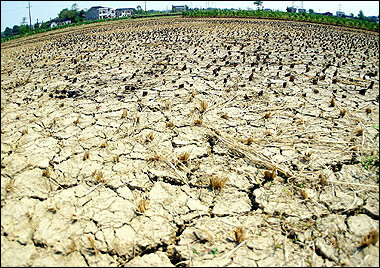Drought could reduce grain output in W. China
(AFP)
Updated: 2006-05-16 10:25
Large swathes of north and west China are plagued by a
prolonged drought that has dried up reservoirs and wells, and destroyed more 60
percent of the winter wheat crop in the worst-hit areas, the Food and
Agriculture Organization said.

A dried up field at a farm
in China, in 2003. Large swathes of north and west China are plagued a
prolonged drought that has dried up reservoirs and wells, and destroyed
more 60 percent of the winter wheat crop in the worst-hit areas, the Food
and Agriculture Organization said.
[AFP/File] |
"Five million hectares of winter
crops are estimated to have been lost or damaged as a result of inadequate
rainfall and higher temperatures," the UN-agency said, adding that the area
planted with spring crops had also been substantially reduced.
Out of 940,000 hectares of planned spring crops, only 30 percent were
planted, the FAO estimated.
The drought could lead to a significant decline in grain
production in this areas, FAO said.
The provinces most affected by the severe water shortages are Gansu, Hebei,
Inner Mongolia, Ningxia and Yunnan, collectively home to some 170 million
people.
In Ningxia, severe drought began in 2004, and some districts have not had
"significant rainfall" for more than 600 days, FAO said.
In Hebei Province, which counts some 68 million inhabitants, over two million
hectares of agricultural land have been severely damaged by two consecutive
drought seasons, and the level of groundwater has fallen by 60 centimetres.
The Rome-based organization noted that the drought-stricken areas are among
China's poorest, with average per capita rural incomes of 250 to 300 dollars
(155 to 230 euros), depending on the province.
Fully "half of rural households live under the poverty line and have limited
access to food," the FAO said.
Most vulnerable are those in mountain areas, where there are few alternative
sources of income. In many regions, rural populations -- including elementary
school children in Ningxia -- have reduced the number of daily meals from three
to two, according to the FAO alert.
|